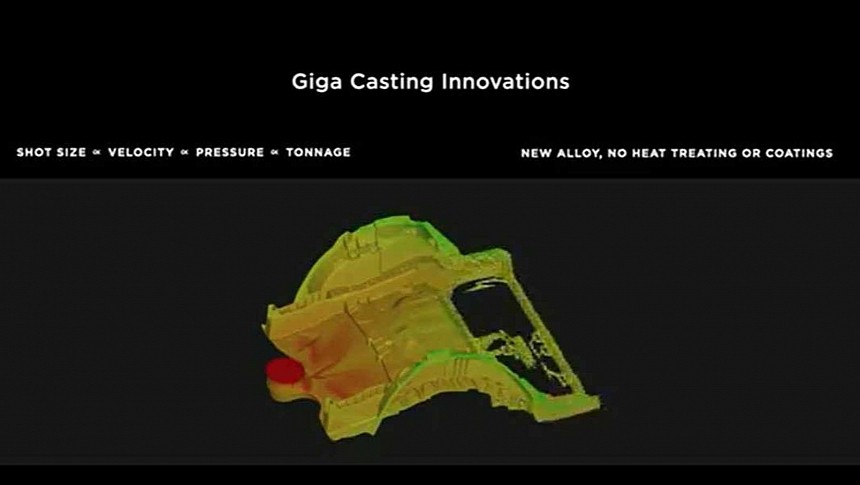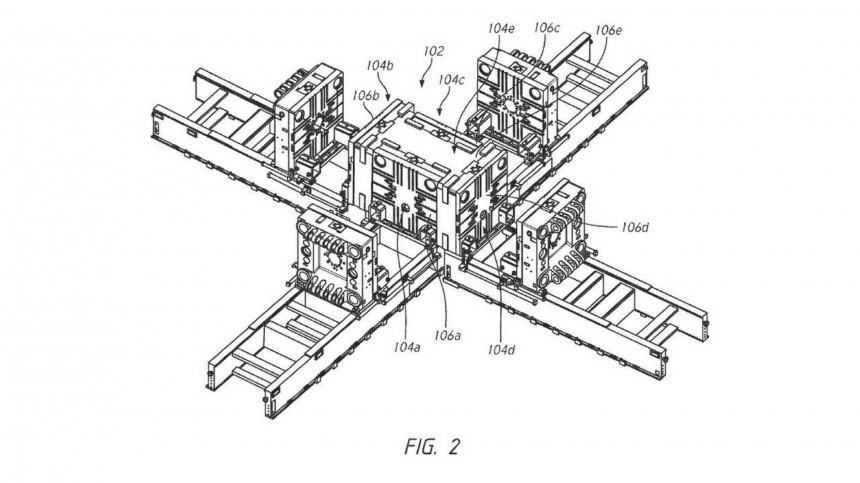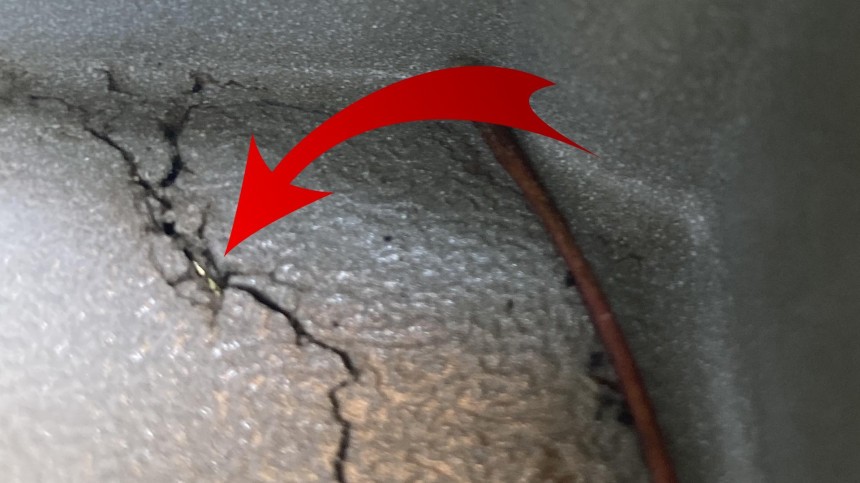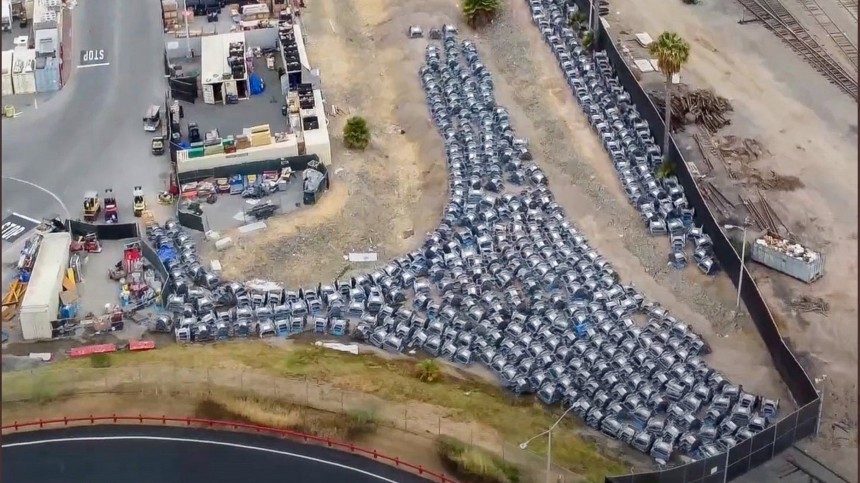When Elon Musk talked on Tesla Battery Day about the massive castings his vehicles would adopt, the CEO explained some technical aspects that allegedly gave his company a manufacturing edge. None of what Musk said is part of what Reuters disclosed would be a quiet breakthrough with the same construction method.
According to the media outlet, Tesla does not want to have three major cast parts as the underpinnings of its vehicles anymore. The company would now be working on a single humongous component for the underbody. In July 2019, Tesla patented ideas for such a manufacturing process, so that comes as no surprise. The shocking element in this situation is that the battery electric vehicle (BEV) maker is still serious about that.
In mass production, the name of the game is production speed. The faster you can make a car, the lower your costs and the more affordable your products will be. Making a single casting instead of joining hundreds of stamped components theoretically saves a lot of time but also brings massive complications.
Reuters said that "casting specialists in Britain, Germany, Japan and the United States" helped Tesla tackle them. One of the problems was creating large metal test molds, which can cost between $1.5 million and $4 million a pop. Tweaks cost $100,000 each time they are necessary. The BEV maker dodged that with 3D printing and industrial sand with machines from ExOne, a division of Desktop Metal. This method reduces the total cost to only around 3% of what a metal test mold would demand. Tesla probably already uses this strategy with current cast parts.
Apart from money, this design process is also said to save time. Instead of spending six months to a year creating these molds, Tesla would spend around two to three months. That should help the company fully develop a car in 18 to 24 months. Volkswagen recently celebrated that it reduced development time to 36 months, but Fiat spent only 18 months to create the Type 198, the second-generation Fiat Bravo. In other words, this is no big deal unless it becomes standard. Developing a car involves way more than just figuring out how to build it: making sure it will have proper build quality may be the most challenging puzzle to solve.
Even after the final molds are ready, Tesla has another issue. Subframes have to have hollow parts to save material and to work as crash boxes. The only way the BEV maker found to create these recessed areas is with solid sand cores. After the part is ready, the sand is removed. Take notes: this will be crucial for this story a bit further. Before that, I have to address the main advantage this system allegedly offers.
At Tesla Battery Day, Musk confirmed that the BEV maker developed a new alloy that did not need heat treatments after the component cooled down. Remember the name of the game? A part that does not demand another industrial step saves time. According to Reuters, that changed.
The castings presented different behaviors when cast in sand test molds compared to the metal test molds. When that happened, they "failed to meet Tesla's criteria for crashworthiness and other attributes." Casting specialists would have solved that with special alloys, fine-tuning the cooling process, and "an after-production heat treatment." What changed for Tesla's cast parts to need that now? What about the competitive advantage the previous process offered?
It makes you wonder if the cracked front casting that I started writing about on August 25 has anything to do with that. Not only that case, specifically, but what it revealed about these components. Tesla itself suggested there are other cases that led it to determine the cracks were not a safety issue.
It may be the case that the heat treatment will only be necessary for the gigantic casting Tesla is trying to conceive, but that is not clear. This new cast part would be used in the company's affordable car, which is said to have a simpler underbody. Reuters also states it has short front and rear overhangs. If that is really the case, it will be a hatchback or an SUV. The deal is that this allows the unique casting to be shorter than it would be for a Model S replacement or the Cybertruck, for example. Even so, it will be at least 4 meters (157.5 inches) long. That is a massive component to deal with in a factory, particularly at the beginning of an assembly line.
Reuters reports that the humongous casting will demand a die-cast press with a clamping power of 16,000 tons or more. It will also have to be considerably bigger than the machines Tesla currently uses. These tools cannot use sand cores that should help the BEV maker create hollow castings. The solution is to use a different sort of press that injects the molten alloy more slowly. Although that is good for the cast quality, it obviously demands more time. When the name of the game is saving it as much as possible, that makes no sense. Reuters stresses that the quiet breakthrough Tesla supposedly achieved may not be used.
Summing that all up, this new casting method will require more time than the one Elon Musk announced at Tesla Battery Day. It will demand heat treatment and different presses that inject the molten alloy at lower speeds. Considering how big this unique casting will be, it will also be more challenging to move it around the factory, heat it up and cool it down. There are several heat treatment methods for castings, and Reuters did not mention which will be the more adequate for Tesla's components.
If these matters were not enough for the BEV maker to give up the idea, what about repairability? If Tesla's affordable car crashes, how do you fix its one-piece underbody? You can't just remove the affected areas and weld a new one in place because Tesla will only make one component. Any crash that affects it will force insurance companies to write the vehicle off. That's a pretty lame strategy for a car that should be affordable – to purchase and repair.
In mass production, the name of the game is production speed. The faster you can make a car, the lower your costs and the more affordable your products will be. Making a single casting instead of joining hundreds of stamped components theoretically saves a lot of time but also brings massive complications.
Reuters said that "casting specialists in Britain, Germany, Japan and the United States" helped Tesla tackle them. One of the problems was creating large metal test molds, which can cost between $1.5 million and $4 million a pop. Tweaks cost $100,000 each time they are necessary. The BEV maker dodged that with 3D printing and industrial sand with machines from ExOne, a division of Desktop Metal. This method reduces the total cost to only around 3% of what a metal test mold would demand. Tesla probably already uses this strategy with current cast parts.
Even after the final molds are ready, Tesla has another issue. Subframes have to have hollow parts to save material and to work as crash boxes. The only way the BEV maker found to create these recessed areas is with solid sand cores. After the part is ready, the sand is removed. Take notes: this will be crucial for this story a bit further. Before that, I have to address the main advantage this system allegedly offers.
At Tesla Battery Day, Musk confirmed that the BEV maker developed a new alloy that did not need heat treatments after the component cooled down. Remember the name of the game? A part that does not demand another industrial step saves time. According to Reuters, that changed.
It makes you wonder if the cracked front casting that I started writing about on August 25 has anything to do with that. Not only that case, specifically, but what it revealed about these components. Tesla itself suggested there are other cases that led it to determine the cracks were not a safety issue.
It may be the case that the heat treatment will only be necessary for the gigantic casting Tesla is trying to conceive, but that is not clear. This new cast part would be used in the company's affordable car, which is said to have a simpler underbody. Reuters also states it has short front and rear overhangs. If that is really the case, it will be a hatchback or an SUV. The deal is that this allows the unique casting to be shorter than it would be for a Model S replacement or the Cybertruck, for example. Even so, it will be at least 4 meters (157.5 inches) long. That is a massive component to deal with in a factory, particularly at the beginning of an assembly line.
Summing that all up, this new casting method will require more time than the one Elon Musk announced at Tesla Battery Day. It will demand heat treatment and different presses that inject the molten alloy at lower speeds. Considering how big this unique casting will be, it will also be more challenging to move it around the factory, heat it up and cool it down. There are several heat treatment methods for castings, and Reuters did not mention which will be the more adequate for Tesla's components.
If these matters were not enough for the BEV maker to give up the idea, what about repairability? If Tesla's affordable car crashes, how do you fix its one-piece underbody? You can't just remove the affected areas and weld a new one in place because Tesla will only make one component. Any crash that affects it will force insurance companies to write the vehicle off. That's a pretty lame strategy for a car that should be affordable – to purchase and repair.



























